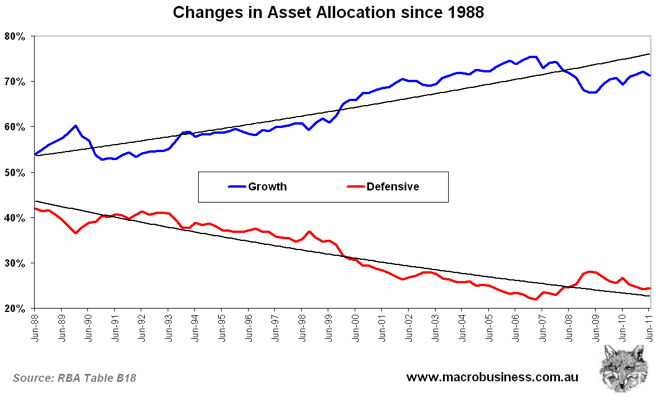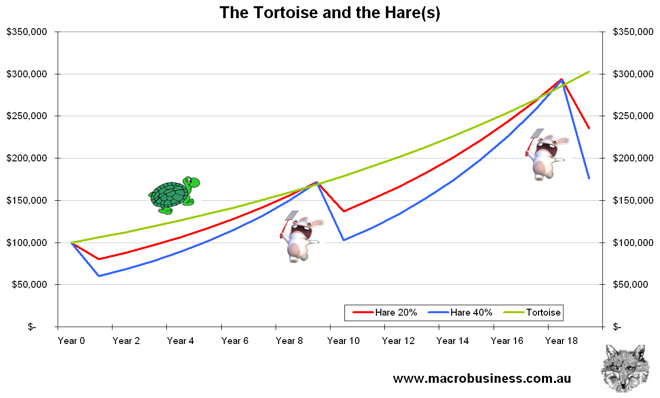We all bemoan the state of our super when we open our statements each year particularly given the rolling ongoing crises that beset the share market. Yet the common wisdom is to always look to the long term and eschew focusing on the short term gyrations.
You’ve likely heard that to fund your retirement, your super fund should return inflation plus three per cent. To achieve this, you’ve been told to allocate nearly three quarters of your retirement savings into growth assets, mainly shares, or you will miss out on their growth potential and have your savings eroded by inflation if you let them sit “idle” in cash.
The reality is most super funds cannot achieve this performance nor capture the upside potential – “they’re dreaming” – as Darryl Kerrigan once put it. According to SuperRatings, the average return for the 50 largest “balanced” super funds over the last 5 years is 1% per year. Over a 10 year period it averages 5.1% per year.
Across all types of super funds (except self managed), returns have averaged 3.3% per year – or just 0.3% above inflation. Dreaming indeed. The problem is further compounded because the averages hide the inevitable volatility that comes with “investing” in growth assets.
In Part One I explained a different technique to overcome the dual problem of underperformance and volatility – the barbell portfolio. First, I contended that your super is for saving, not speculating, and should mainly comprise solid investments like bonds, term deposits and annuities.
Secondly, you should still have exposure to growth assets, but you must consider the risk before the potential return as the long term implications can be devastating to your retirement savings.
And as I’ve mentioned previously, both an amateur and professional investor, using a Self-Managed Super Fund (SMSF) can enhance their returns simply through the choices not available to the retail or industry super fund, a classic example is term deposits (although some retail funds are offering this option now).
How did we get here?
An examination of the managed fund industry’s change in asset allocation over time is illustrative. Consider that since 1988 (when earliest data is available), the industry has gone from a 25% exposure to Australian shares to a 43% exposure:
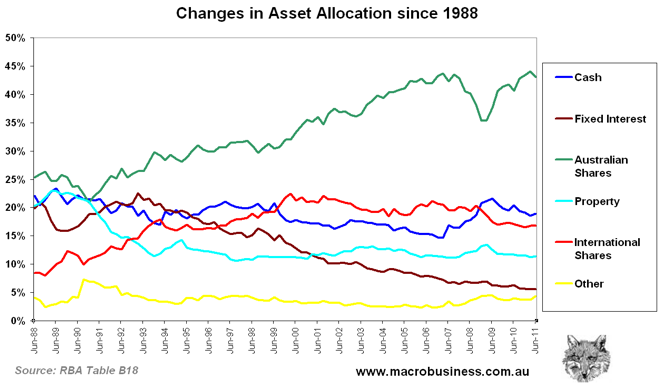
Note that international shares exposure has also grown, from 8% to 22% in 2000, remaining approximately at that level since, as all developed markets remain stuck in an secular bear market, which explains these returns:
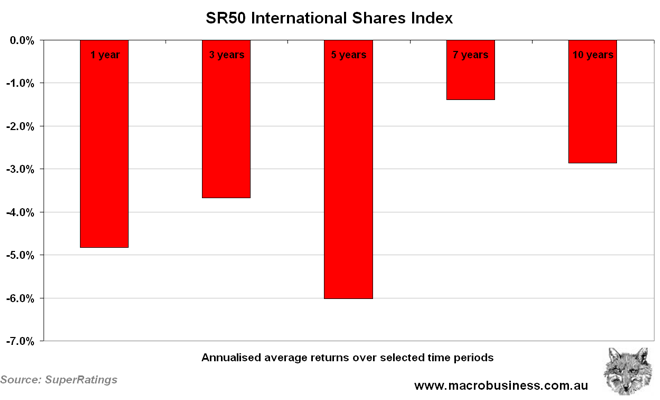
Delineating the different investment choices into the traditional “growth”, i.e shares and property, and “defensive” – cash and fixed interest, the structural change in the industry is even more stark:
Interestingly though, defensive assets have outperformed across almost every time period, even during the biggest bull market in history and declining interest and depth in the sector, exarcebated by the paydown of Federal government debt.
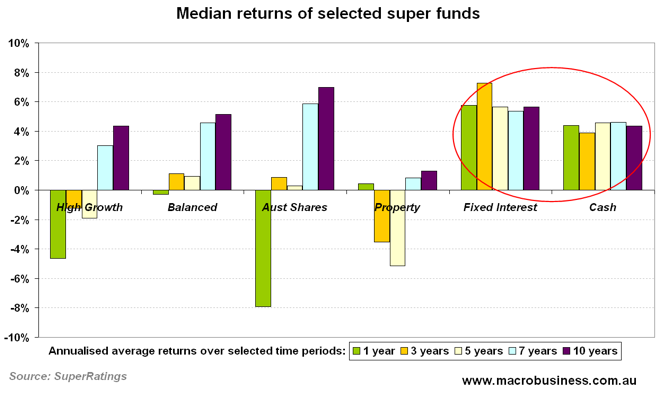
Only over a 10 year “average” period can a purely Australian share option outperform its boring brethren, except the drawdown volatility is extreme. Strangely the returns do not match the All Ordinaries Accumulation Index which shows a 9.1% average return (including 4% in dividends) in the same period. That’s a lot lost to management fees!
The Tortoise and the Hare
Here’s an analogy to explain why the downside matters more than the upside.
Imagine two portfolios – the Tortoise and the Hare. The Hare is your typical “balanced” fund, with over 70% assets in shares and property, the rest in cash and fixed interest. Over a thirty year period, the Hare will experience some “fast” years, earning well over 10%, and occasionally will fall into a puddle, earning nothing or losing a few percent. Not so often, by not looking where he is going, he falls into a deep hole, losing 20-40% of the portfolio. He climbs out and sets off again. The Tortoise takes a different path, avoiding the holes and puddles, plodding along, always earning between 4 and 8% year in, year out. But “on average” the Hare should win, right?
The reality is the Hare hasn’t understood time and opportunity cost. To get back to even after a 20% loss – a common occurrence in the last 4 years – requires a 25% positive return. A 40% “once in lifetime” loss requires a 66% positive return. Even if he has successive 10% returns each year, it will take the Hare 8 years in a row to catch up to the Tortoise earning a positive 6% year in, year out. And that’s without falling into any more puddles or holes.
Compare the Funds
So can a barbell portfolio work and why? Let’s compare the typical balanced super fund against an “amateur” and a “professional” barbell portfolio over 10 and 20 year periods.
The amateur portfolio will be constructed in accordance with the typical options available to the industry or retail super fund, with a 90/10 weighting of “investment” and “speculative” assets:
- 30% cash (represented by 90 day bank bill rate)
- 60% bonds (representeeed by UBS Bond Index)
- 10% “Australian shares” index
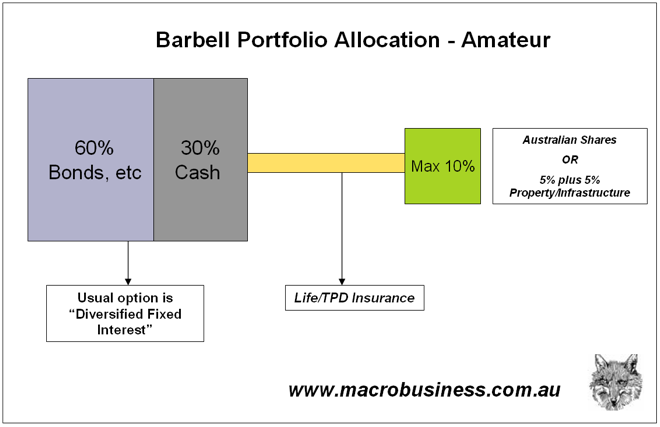
The professional portfolio will have a greater weighting to the speculative, with a 45/10/45 split between “investment”, “security” and “speculative” assets. (Note, this would normally be called a “conservative” portfolio)
The investments will comprise:
- 20% in 3 year term deposits (data from RBA)
- 20% in the UBS Bond Index
- 5% in high dividend yielding blue chip stocks (ASX50 returns are assumed)
The speculative assets will comprise:
- 30% in the All Ords
- 10% in the ASX Small Ords
- 5% in the S&P500 Index.
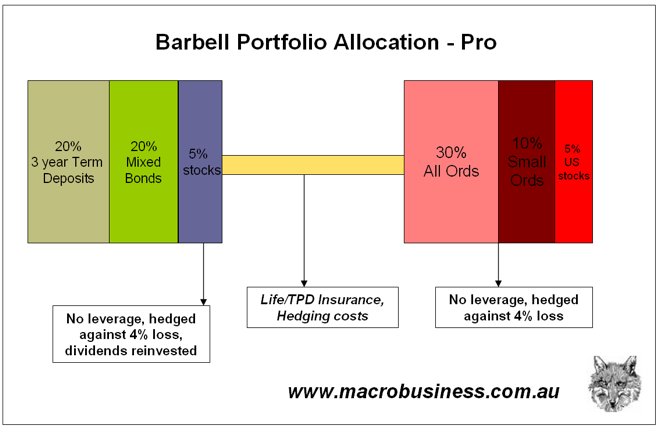
I’m using these as proxies against speculative asset picking strategies likely employed by a professional investor. These assumptions also do not include the use of leverage or any market timing and are probably conservative given the Cooper review recently showed how SMSF trustees have provided outsize returns.
Importantly, I’ve assumed an ongoing 1% annual cost in security assets and hedging costs across the entire portfolio, whereby the maximum drawdown is limited to 4% of total capital (more on that strategy later).
Assuming a starting balance of $100,000 over a 10 and 20 year period, the results are as follows:
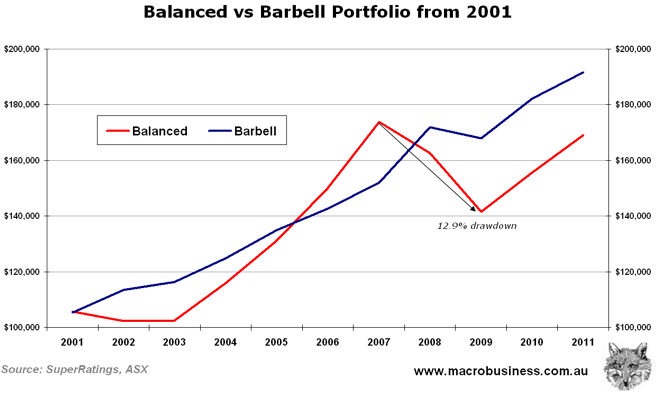
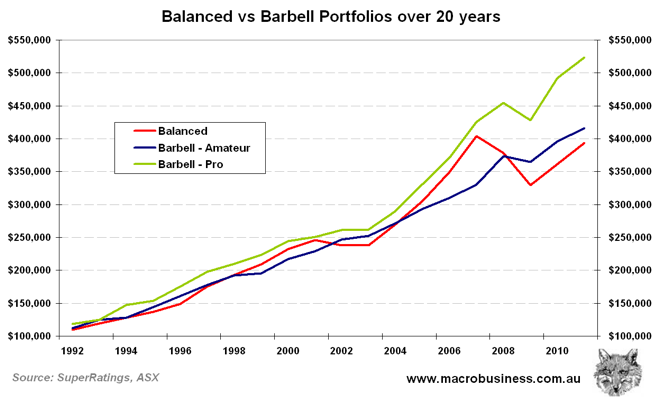
The potential advantages behind the barbell portfolio are numerous. First, both versions outperform the balanced fund across both timeframes, showing the advantage of absolute vs average returns.
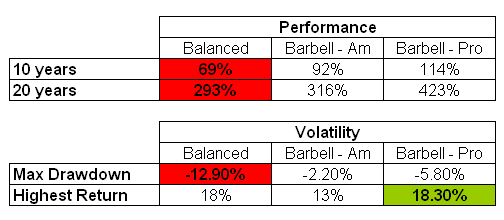
More importantly, the downside volatility is limited, with maximum drawdowns of 2% and 6% for the amateur and professional barbell portfolios respectively, compared to almost 13% for the balanced fund (remember this is an average over a 12 month period. In reality, the typical balance fund dropped over 20% in value during the GFC. Not a good time to retire.)
This absolute return both allows peace of mind for retirees and avoids the “Hare” problem for accumulators.
Finally, the amateur barbell in particular is relatively easy to implement for the average investor and historically has not required any switching or active management. This may change as we move into a secular bear market and stressful macroeconomic conditions, particularly on bonds.
How to do it
The amateur barbell portfolio described above can be easily constructed with the required investment options available within the most popular retail and industry super funds.
Remember the 90% allocation, the vast majority of your fund should be in secure “investment” assets with almost zero potential for drawdown or loss of capital. Most funds have a “cash” option and a “bonds” or “fixed interest” option available. Consider a bias to the latter, e.g up to 60% in bonds, as the top 25 diversified fixed interest funds have returned at least 5% per annum over the last 10 years. Some funds will even have a “term deposit” option, which could return as much as 6% per annum.
The professional investor should consider high dividend paying “Wonderful” listed companies with an excellent track record of earnings reliability and other attributes. However, these stocks cannot be considered “investments” if they cannot be hedged, either through a put option or short Contract for Difference (CFD). As this is available for most stock indices (e.g ASX50, ASX200 etc) a hedged allocation could be used instead of individual stocks, but following the index is assuring mediocrity.
A further enhancement available is the use of corporate bonds, e.g Woolworths Notes and hybrid securities. These can provide better returns than government bonds or term deposits, but have similar risks to equities. As a result, I would preferably like a hedge against any default eventualities and/or not rely on too large or concentrated allocation.
The speculative side of the barbell – no more than 10% for an amateur – would be best allocated to Australian shares only. I would not consider international shares, due to the structural inability of fund managers to provide even a positive return over a 10 year period. A small amount in property or infrastructure – even up to 5% – could be considered due to the income stream, but remember these assets are extremely risky and illiquid.
Professional investors have a completely open world available to them for speculative endeavours, and doesn’t the financial world like to remind you of it? I would suggest someone starting out should slowly increase their allocation to this side of the barbell, once they are aware of the risks and possibilities involved. The key point is you have to consider the chance that you may lose all of your capital speculating, so risk management is vital. This can be done either through physical stop losses (a pre-organised order given to your broker if a share falls a certain percentage or level) or more advanced techniques.
Don’t forget security – the bar that binds the two together. In a non-DIY fund, the best security asset is life and disability insurance where the costs are usually much cheaper due to the group discounts within the fund.
Conclusion
Relying on market volatility and traditional asset allocation to provide the return in your super has been shown as unreliable even in the biggest bull market in history.
Regardless of market conditions, either blue skies or impending doom, and whether you want a hands-off or self managed approach to your super, you need constant positive or “absolute” returns to both build and protect your precious retirement savings.
This is Part Two of a two-part series on the Barbell Portfolio for Superannuation. Part One explained the concept in detail and can be read here: Tackle risk for super returns
Previous articles and Special Reports which explain the background and research behind these concepts are archived under the links “Investing” and “Superannuation“
